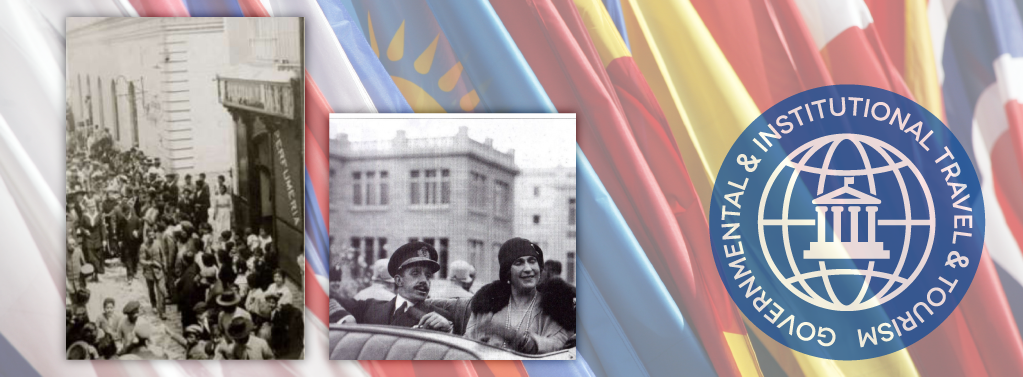
In April 1916, the then King and Queen of Spain, Alfonso XIII and Victoria Eugenia de Battenberg, paid a visit to the town of Ecija (Seville, Spain). During the visit, which lasted approximately one hour, the King and Queen made a tour through the streets of the town, being received by local authorities and citizens. They arrived and left Ecija in automobiles.
More than one hundred years later, in February 2020, their counterparts, Philip VI and Letizia, the current King and Queen of Spain, paid a visit to the same municipality. The visit lasted approximately two hours, and it boasted a significant deployment of security, protocol and media that shows the significant evolution and complexity that have reached the trips of Governments and Great Institutions today. It is interesting to make a comparison of both trips in order to appreciate these changes, which are, without a doubt, tremendously considerable in many aspects.
For example, the main difference between the two trips is their motivation. In 1916, the kings made a leisure trip, a simple tourist visit, guided by the Marquises of Peñaflor, who accompanied them on a walk through the town. However, in 2020, King Philip VI and Queen Letizia, made a trip motivated by an institutional act: the city council of Ecija was going to have the honor of awarding the King with the Baton of Command, and the latter, would bestow the Princess of Girona Award to the Sagrada Familia schools. This influenced the meticulous preparation of the trip, both by the Royal House and the people of Ecija, during the stage of considerations prior to it. Thus, the date was marked in the annual agenda of the Royal House for February 6, and the local and national media were informed about the reasons and the main details of the visit.
In contrast, there are no indications that there was a stage of prior considerations in the 1916 trip, as there is not much information prior to the visit in the media of the time, nor evidence of institutional planning in advance of the trip. This is due, in part, to the fact that this visit could be framed within what we now call private or unofficial trips, which are included in the category of GITT (Governmental and Institutional Travel and Tourism) trips, but which entail less planning and protocol requirements than official ones; those in which the personalities exercise a certain institutional role, the latter being trips motivated by the exercise of their functions as members of a government or institution.
When it comes to private leisure trips, or for personal reasons of any kind, these people usually prefer to keep all details of the trip from being known. Well, in 1916, this was something that was not respected. The population had not been informed about the visit that was going to take place and, however, there was a leakage of information that was picked up in the press of the time -such as "La Opinión Astigitana"-, so that the people of Ecija did get to know certain details of the trip before it took place. This is one of the reasons why in the GITT trips great importance is given to which people receive or access to what specific information, as leaks can even endanger the physical integrity of the people who make up the Delegation.
But although the 2020 visit was planned and included in the official agenda of the Royal Household, the local authorities were notified not too much in advance, which did not provide much room for maneuver. Even so, the relevant delegations from the local, provincial and regional governments were designated and were present on the appointed day to attend and accompany the Royal Delegation. Besides, within the preparations for the visit, the corresponding advance trip was organized in which, a week before the visit, members of the security and protocol teams were transferred to Ecija in order to check all the important aspects of the delegation's route, to request the necessary information from the people who would be in contact with the King and Queen during the visit and to hold the preparatory meetings with the counterpart teams and the regional authorities.
In a different order of ideas, the differences between the means of transport used for both displacements are also remarkable. In 1916, the kings had been inaugurating the Great Circuit of the future Ibero-American Exposition of 1929 and visiting the finished pavilions of the same one in Seville, from where they moved to Ecija in a Hispano-Suiza 30, accompanied by a motorcade conformed by four more cars, in which the Maques de Viana, the Duke of Santo Mauro and two more unidentified authorities were traveling. Upon their arrival in Ecija, they rested in the Palace of Peñaflor, from where they were walked by the lords of the palace, the Marquises of Peñaflor, on a sightseeing tour of the city.
On the other hand, King Felipe and Queen Letizia traveled in the Dassault Falcon 900B to the airport of Seville, where a helicopter was waiting for them to take them to Ecija. It is also known that, in case of adverse weather conditions, there was an alternative plan, whereby the Falcon would land in the city of Cordoba, 52 kilometers from Ecija, and the monarchs would have been transferred by motorcade to Ecija.
In 1916, there was also no official reception as such for the monarchs; just the one given to them by the Marquises of Peñaflor when they arrived at the palace. However, in 2020, as it was an official visit of the kings, the authorities of Ecija officially received them in the Municipal Historical Museum, where the handing-over ceremony of the Baton of Command took place. At the end of the ceremony, the kings, accompanied by the authorities went to the different points marked on the route to finally leave the city in the same helicopter that took them there, and embark at the airport of Seville in the Falcon to return to Madrid. This also contrasts with the device used in 1916; in that visit, King Alfonso XIII and Queen Victoria Eugenia left Ecija in the same vehicle in which they had arrived, accompanied by the corresponding motorcade that had escorted them on their arrival. Both visits coincide in using the same transports for the outward and return journeys, but these are completely different, due to the places of origin from which both retinues departed, as well as the different periods in which each of the journeys took place.
It is evident that the century that separates one visit from the other is enough for both to be very different; times change and the security of these people increases significantly with the passing of the years... However, it must be taken into account that, as we have mentioned, both trips do not have the same motivation and, therefore, their conditions change. Despite this, a trip by any member of a current royal family, with private motivation, would also have much more security than the one made by Alfonso XIII and Victoria Eugenia, back at the dawn of the last century and we wanted to use to make a comparison and, to visualize with examples, the evolution of GITT trips over 100 years of history.





